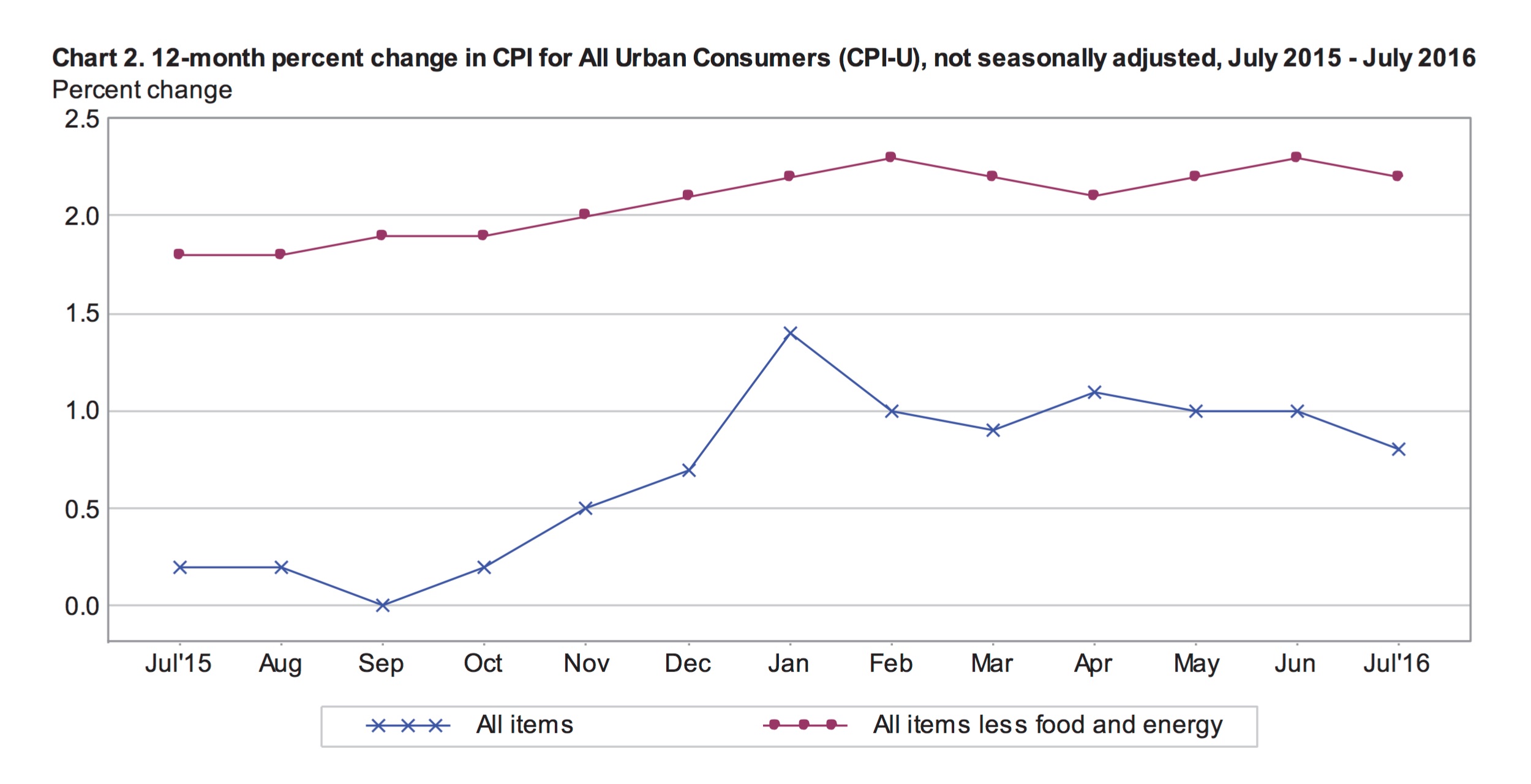According to this morning’s monthly inflation report from the BLS, consumer prices fell 0.2% in July after rising 0.3% in June. With seasonal adjustments, overall price levels were flat in July following increases of 0.2% in both May and June. Over the 12-months ending in July, the consumer price index for all urban consumers (CPI-U) added 0.8%, down from 1% in the two previous months. Today’s report will disappoint investors who had been expecting slightly higher numbers. It also quells expectations that the Fed will raise interest rates in the near term.
The core index or all-items index excluding food and energy is an important indicator of true price trends as food and energy prices are volatile and impacted by extraneous factors. The core index was flat in July following an increase of 0.2% in June. Year-over-year, core prices were up 2.2%, down from 2.3% the previous month. Slowing core inflation may be an indication of some underlying economic weakness.
Monthly Inflation
The seasonally adjusted energy index fell 1.6% in July following 4 consecutive months of positive gains. The decline can mostly be attributed to a 4.7% monthly drop in the price of gas. On the other hand, the price of natural gas posted its largest monthly gain in over two years, up 3.1%.
Overall food prices were flat in July. The index for food at home slipped 0.1% but was balanced by a 0.2% increase in the index for food away from home. Food at home accounts for 13.7% of the overall CPI-U and food away from home is 5.7%. At the grocery store, meat prices fell 0.7% while the index for fruits and vegetables gained 0.3%. Prices were lower in four of the six major grocery store food indexes.
With seasonal adjustments, the index for all items less food and energy was up only 0.1% in July, slowing from 0.2% in each of the previous three months. Within this index, shelter prices climbed 0.2%, slowing from the previous three months. Medical care service costs grew 0.5% in July and the price of medical care commodities increased 1.1%. The index for used cars and trucks dropped 1% in July, adding to similar declines in recent months. The indexes for airfare, communication, and recreation all declined in July.
Seasonally Adjusted Monthly % Change in CPI-U by Category (2016)
| January | February | March | April | May | June | July | |
|---|---|---|---|---|---|---|---|
| All Items | 0 | -0.2 | 0.1 | 0.4 | 0.2 | 0.2 | 0.0 |
| Food | 0 | 0.2 | -0.2 | 0.2 | -0.2 | -0.1 | 0.0 |
| Energy | -2.8 | -6.0 | 0.9 | 3.4 | 1.2 | 1.3 | -1.6 |
| Gasoline | -4.8 | -12.5 | 2.2 | 8.1 | 2.3 | 3.3 | -4.7 |
| Fuel Oil (non seasonally adjusted) | -6.5 | -2.9 | 1.7 | 1.9 | 6.2 | 3.7 | -1.5 |
| Electricity | -0.7 | -0.2 | 0.4 | -0.3 | -0.2 | -0.5 | 0.5 |
| Utilities (piped gas service) | -0.6 | 1.0 | -0.7 | 0.6 | 1.7 | -0.4 | 3.1 |
| Energy Services | -0.7 | 0.1 | 0.2 | -0.1 | 0.2 | -0.5 | 1.0 |
| All Items Less Food and Energy | 0.3 | 0.3 | 0.1 | 0.2 | 0.2 | 0.2 | 0.1 |
| Services Less Energy Services | 0.3 | 0.3 | 0.2 | 0.3 | 0.4 | 0.3 | 0.2 |
| Shelter | 0.3 | 0.3 | 0.2 | 0.3 | 0.4 | 0.3 | 0.2 |
| Transportation Services | 0.4 | 0.2 | 0.2 | 0.7 | 0.3 | 0.3 | -0.2 |
| Medical Care Services | 0.5 | 0.5 | 0.1 | 0.3 | 0.5 | 0.2 | 0.5 |
Annual Inflation
Food prices were only up 0.2% over the 12-months ending in July. The index for food at home declined 1.6%; the index for meat poultry fish and eggs dropped 5.6% and the index for dairy and related products fell 3.1%. However, the cost of food away from home grew 2.8% to temper the decline in overall food prices. The energy index fell 10.9% over the year ending in July. The index for energy commodities fell 19.4% including a 19.8% decline in gas prices. Over the same period, the index for energy services only declined 0.9%.
The core price index increased 2.2% year-over-year in July, following an annual gain of 2.3% in June. This includes a 3.3% annual increase in shelter costs as well as a 4.1% increase in the index for medical care services. The index for transportation services, which accounts for nearly 6% of the overall index, climbed 3% year-over-year, including a 6.3% jump in the price of motor vehicle insurance and a 4.6% decline in airline fares.
Inflation By Region
For the year ending in July, inflation was above the national average in larger cities; cities with populations over 1.5 million posted overall inflation of 1.1%, while those with populations between 0.5 and 1.5 million only recorded inflation of 0.4%. Inflation was also significantly higher in western urban areas compared to other regions. Large, western urban areas had 1.6% inflation over the year, twice the national average.
In July prices fell most drastically in the midwest. The midwest urban index dropped 0.5% and in Chicago prices fell 0.8% month over month. The south urban index also declined in July, down 0.2%. Month-over-month, prices fell more in smaller cities.
| Urban Population | 12-month | August |
|---|---|---|
| over 1.5 million | 1.3% | 0.1% |
| 50,000 to 1.5 million | 0.7% | 0.1% |
| under 50,000 | 0.8% | -0.1% |
| Urban Regions | 12-month | August |
|---|---|---|
| Northeast | 1.1% | 0.1% |
| Midwest | 0.6% | 0.1% |
| South | 1.0% | 0.1% |
| West | 1.6% | 0.1% |
Outlook for the Economy
The next FOMC meeting is on September 21st. According to the CME Group’s FedWatch tool, the markets are pricing in an 82% likelihood that the Federal Reserve will leave rates unchanged at this meeting. The same tool predicts that rates will remained unchanged throughout the year with a probability of just under 50%.
Given the unprecedented nature of the current low interest rate environment, policy may need to be adjusted. Policymakers are beginning to reconsider the central bank’s framework – which aims to maintain an annual inflation rate of 2%. According to John Williams, president of the Federal Reserve Bank of San Francisco:





